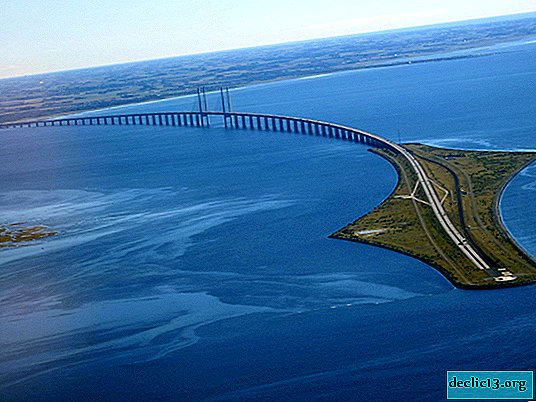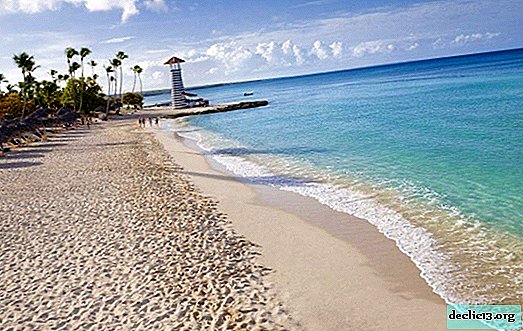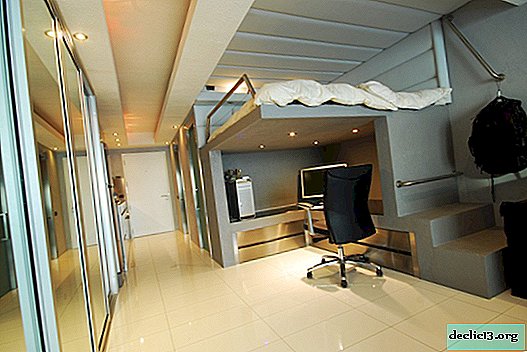Oresund Tunnel Bridge - the most unusual in Europe
The Danish capital and the Swedish city of Malmo are connected by a two-story Öresund bridge. The border of states runs exactly along its middle. And this is not news for you if you watched the detective series "Bridge", which made the miracle of engineering a hallmark of the two countries.

Bridge between Copenhagen and Malmo
This unique structure, on two levels of which a continuous stream of cars and trains moves, is the longest (7.8 km) combined highway in Europe, as well as part of the major European highway E20. One of the merits of the bridge is that it helped Grand Belt unite continental Europe, Sweden and Scandinavia. In addition, the Öresund Tunnel Bridge is a vibrant and photogenic attraction. Especially intriguing is how suddenly he hides under the water.

In Denmark it is called Øresundsbroen, in Sweden - Öresundsbron, but the company that designed the bridge insists on Øresundsbron, rightly considering this architectural masterpiece a symbol of the region with a common cultural identity.
FACT: The height, width and length of the bridge between Denmark and Sweden, as well as the materials from which it will be made, and other details were discussed by a specially formed group of the Oresund Consortium. The consortium, consisting of an equal number of Swedes and Danes, acted as the owner and contractor.
How to build a bridge connecting Denmark with Sweden
The idea of connecting the shores of the Öresund Strait has inspired engineers since the 1930s, but there was no money for such a large-scale construction. They had to be found when the volume of the Swedish-Danish ferry service reached such limits that the question of the appearance of a land road stood in full swing.

The project began in 1995 after many studies showing that Saltholm Island (Sol Island) located in the middle of the strait cannot become a strong point for the Öresund Bridge. Construction work and the subsequent operation of the structure could cause irreparable harm to the representatives of the feathered world living here. Therefore, it was decided to build an artificial island, which is located one and a half kilometers south of Saltholm and received the witty name Peberholm (Peretz island) from the inhabitants of Denmark.
 Peberholm
PeberholmThe building material for creating the island, four kilometers long and an average width of five hundred meters, was rock fragments and rocks extracted from the deepening of the bottom. The man-made origin of the island did not prevent it from becoming a conservation area, which only scientists have access to. They conduct experiments here, proving that life can originate in territories that were created artificially. By the way, the experiments were successful, as some species of plants had already taken root on the island, small rodents settled.

The above-water part of the bridge between Sweden and Denmark begins in Malmö, runs along Peberholm (3.7 km) and dives into a tunnel that ends in the east of the Danish capital, near Kastrup Airport. It was his existence that became the main argument in favor of the construction of the tunnel. Spans and pylons, without the presence of which it would have become impossible for the movement of ships, could impede aircraft that continuously land in this area.
FACT: The Öresund bridge, the construction cost of which is more than thirty billion Danish kroner or more than 4,000,000,000 € (prices of the year 2000), should finally pay off in 2035.

The Malmo-Copenhagen bridge began to be built in the mid-90s. And everything was fine until the workers stumbled upon the bottom of the strait on the shells of World War II. Their safe elimination took a lot of time and effort. In addition, inaccuracies in engineering schemes provoked a skew of one of the parts of the structure. But even these difficulties did not prevent the project from being completed in 4 years. The day of the official opening of the bridge is considered July 1, 2000, when it was visited by the ruling monarchs of the two states.Find out RATES or book any accommodation using this form
Technical specifications and architectural nuances
The bridge between Denmark and Sweden, the photo of which all tourists want to make, is truly a mega-construction:
- The length of the surface part is 7.8 km.
- The length of the underwater tunnel is 4 km, consisting of 3.5 km of the underwater tunnel and almost 300 meters of portals at each end.
- The total length of the road between the states is 15.9 km. The remaining path goes along Peberholm.
- The average height of the bridge above the sea is 57 m. The height of the surface part gradually increases towards the middle and gradually decreases towards Peberholm.
- The surface part weighs 82 thousand tons.
- The width of the bridge is more than 20 m.
- Most of the bridge structure was assembled on land.
- In the middle part of the bridge, two hundred meter pylons rise, and between them there is a span of almost 500 m in length to ensure the unhindered movement of ships.
- Twenty reinforced concrete sections with a total weight of 1,100,000 tons were lowered into the channel dug for the construction of the tunnel.
- Five pipes pass through the tunnel connecting Peberholm and the Kastrup Peninsula on Amager Island, two of which are for trains, two more are for cars, and the other one is for force majeure.


If the residents of Sweden and Denmark, the Eresund bridge and the underwater tunnel have become commonplace, then travelers have something to be surprised. On approaching the Copenhagen airport, an amazing picture will open before you: a giant bridge with trains and cars suddenly “dissolves” in water. This "focus" makes an indelible impression on an unprepared person.

Sitting in a car moving along the Öresund bridge, you will be amazed at its size. It seems that there is no end to it, so you have a chance to admire the breathtaking sea views and enjoy a trip through the tunnel.
Compare accommodation prices using this form
Öresund Bridge: fare and other useful information
Immediately after the opening of the Öresund bridge, it was so expensive that it did not gain deafening popularity among local residents until a discount system was introduced for regular customers. Danish citizens who purchased apartments in Sweden and regularly traveled to the office on the bridge could count on impressive discounts. This had a positive effect on both countries, as wages are higher in Denmark and accommodation is more affordable in Sweden. Many people share life between the two states and are happy to take advantage of the opportunities that the bridge has provided them.

For the convenience of customers, the following lanes are allocated at the toll station through a tunnel through the Aresund spans:
- Yellow - for cash and motorcyclists.
- Greens are for BroBizz users. This device is from the group of toll operators in the Scandinavian countries EasyGo, which allows you to cross more than 50 points of payment.
- Blue - designed for payment by credit cards.

There are signs on the roadway to help you navigate when choosing the right lane.
Bridge Fare between Copenhagen and Malmo is:
- For cars up to 6 meters -59 € (440 DKK or 615 SEK).
- For transport from 6 to 10 meters or with a trailer up to 15 meters - 118 € (879 DKK or 1230 SEK).
- For transport more than 10 meters or with a trailer more than 15 meters - 194 € (1445 DKK or 2023 SEK).
- For motorcycles - 30 € (223 DKK or 312 SEK).
- More detailed information on the fare, as well as check its relevance, can be found on the official website of the road www.oresundsbron.com/en/prices.
Prices on the page are for July 2018.

To many, these figures seem to be overstated, but they are quite comparable with the cost of travel by ferry, which circulated between countries before the commissioning of the bridge. In addition, when buying tickets online you can save up to 6% of the amount that you have to spend at the station. You can also sign up for BroPas, which costs 42 € per year, and save more than 60% of the initial cost of each trip over the bridge.
You can overcome the Öresund bridge and the underwater tunnel by car in about 50 minutes, and by high-speed train in half an hour. Note that the train moves on the lower level, which does not allow to admire the bridge itself.

















